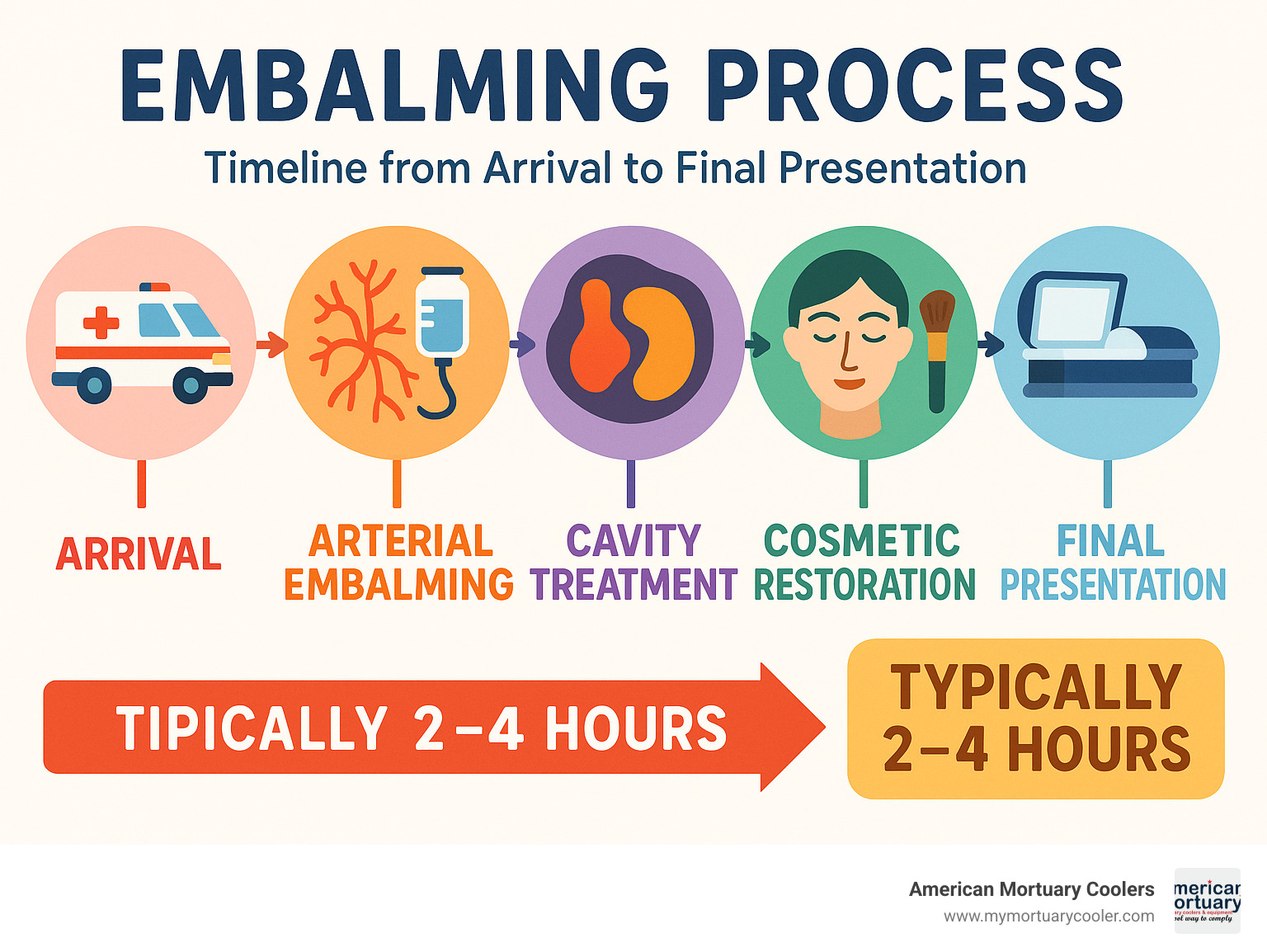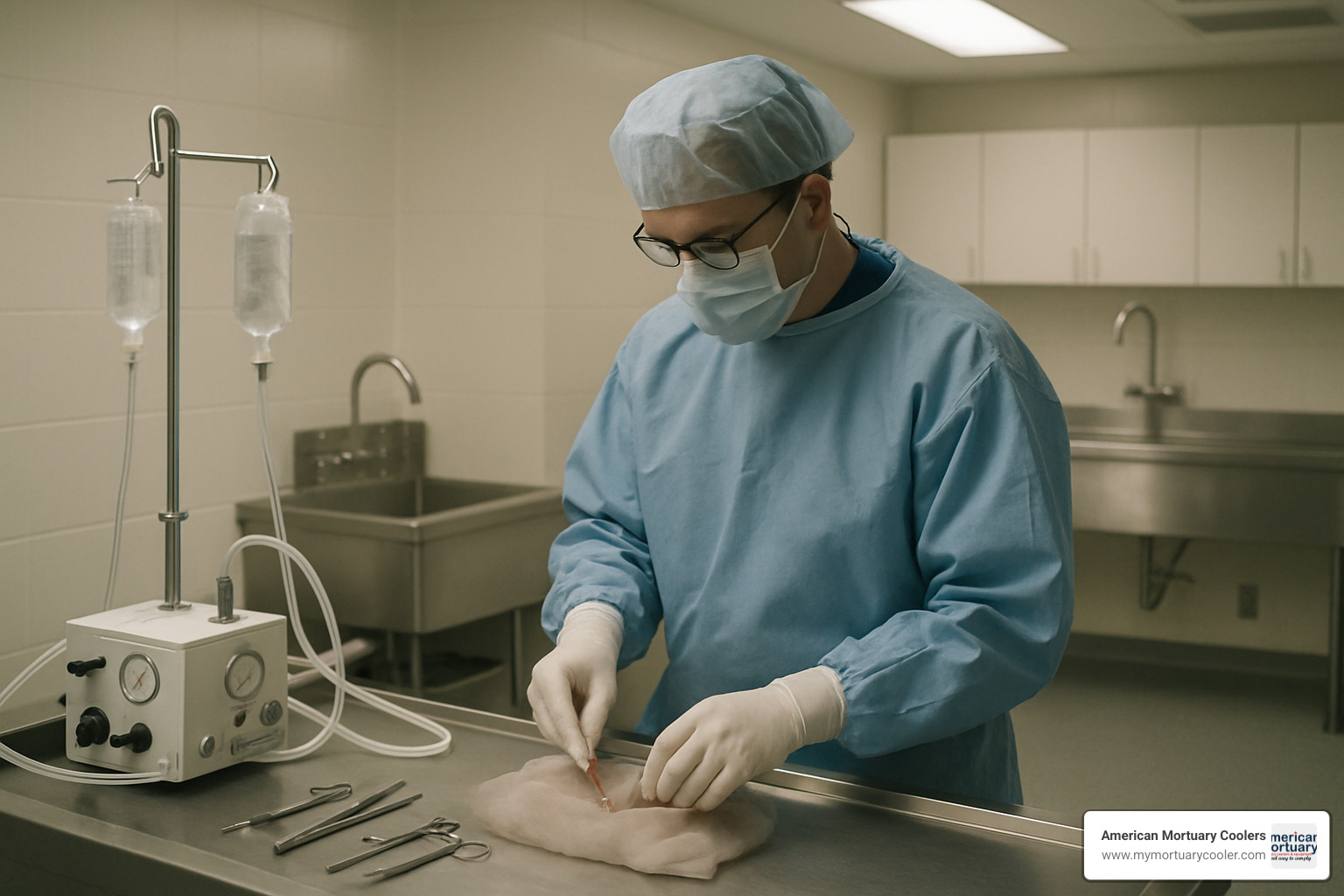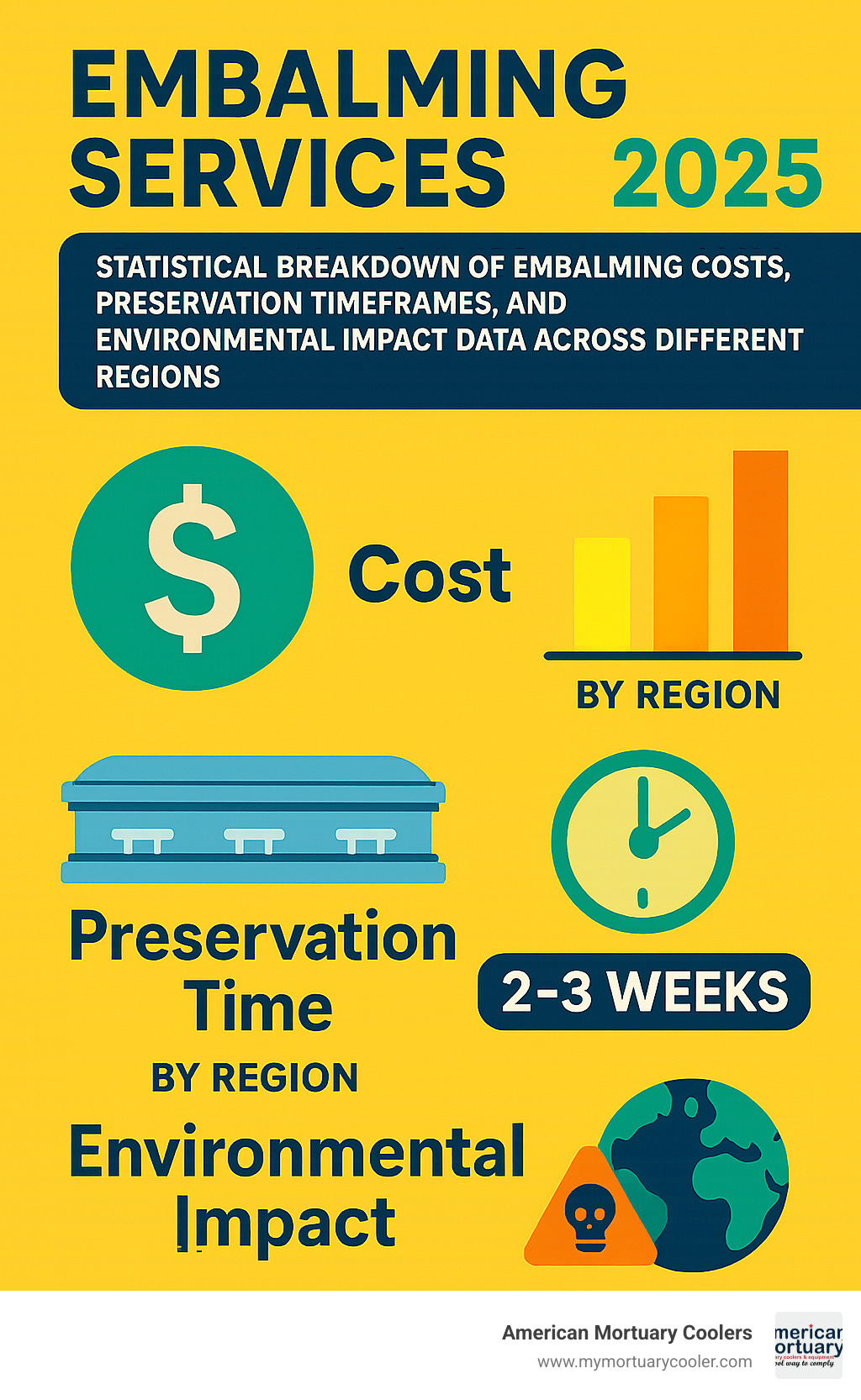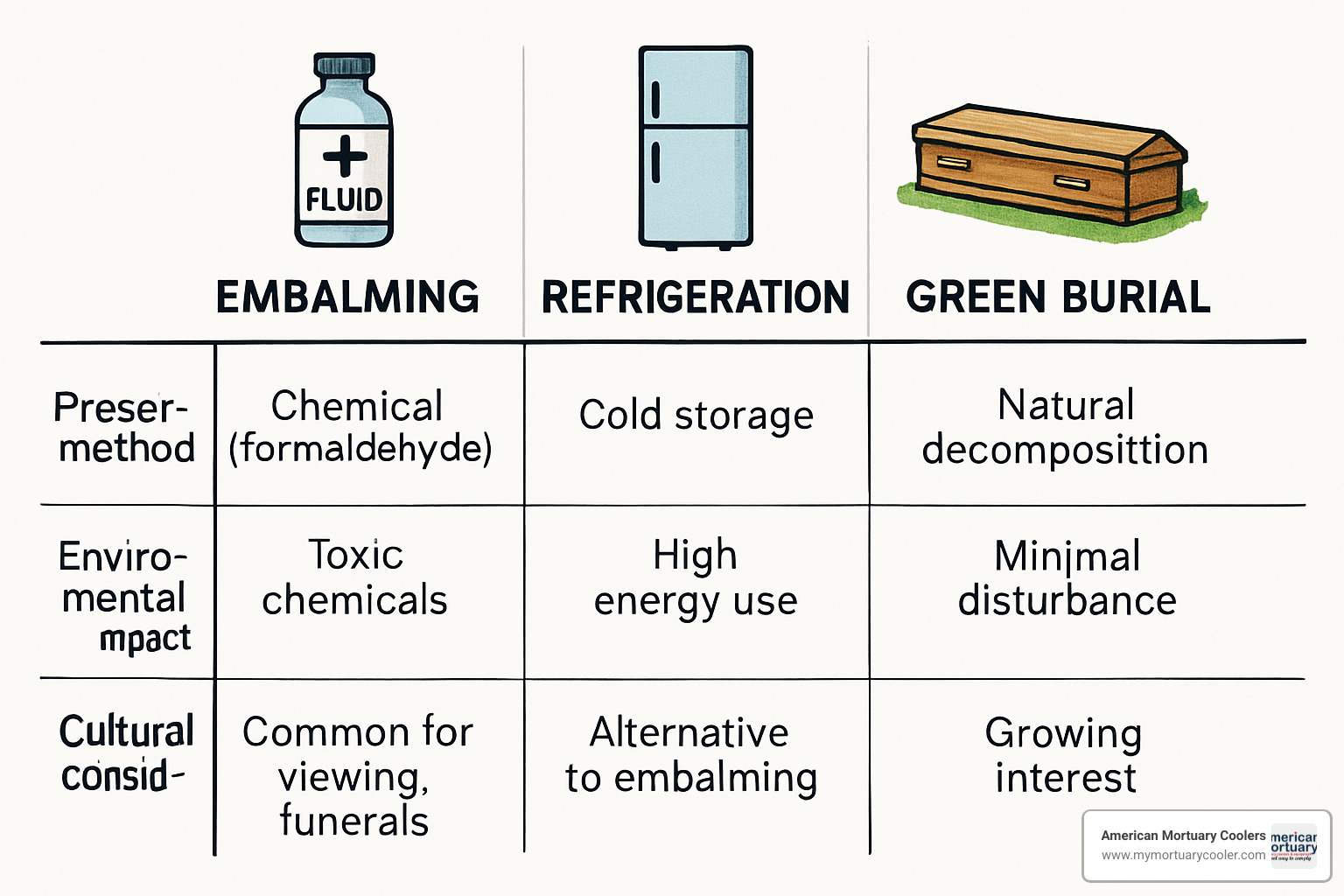
How to Find Embalming Services, Even if You've Never Tried It Before
What Embalming Services Really Are (And When You Need Them)
Embalming services help preserve a loved one's body temporarily to slow decomposition and maintain appearance for viewing or transportation. Most people don't realize that embalming isn't legally required in most situations - it's primarily needed for open-casket viewings, delayed services, or long-distance transport.
Key facts about embalming services:
- Purpose: Preserve body for 2-3 weeks using formaldehyde-based chemicals
- Cost: $500-$1,200 on average in the U.S.
- Time: Takes 2-4 hours to complete the full process
- Legal requirement: Only required for certain contagious diseases or cross-border transport
- Alternatives: Refrigeration, direct burial, or cremation without viewing
The process involves arterial embalming (replacing blood with preservative fluid) and cavity embalming (treating internal organs). Licensed embalmers perform the work in funeral homes, following strict health and safety protocols.
I'm Mortuary Cooler, a national supplier of mortuary cooling equipment who has worked extensively with funeral homes requiring reliable embalming services and refrigeration solutions. My experience helping funeral directors nationwide has shown me how important it is to understand all preservation options available to families.

Embalming services terms to remember:
Understanding Embalming: History, Purpose & Legal Basics
Modern embalming services developed during the American Civil War, when Dr. Thomas Holmes created formaldehyde-based solutions to preserve soldiers' bodies for transport home. What started as a wartime necessity became a cornerstone of American funeral practices.
Today's embalming serves a different purpose - preservation versus decomposition - giving families time to gather, plan meaningful services, and say their goodbyes without the pressure of immediate burial.
What Is Embalming & Why People Choose It?
Embalming services involve a multi-step procedure using formaldehyde-based chemicals to slow decomposition and preserve bodies for viewing. The process replaces blood with preservative fluid through major arteries while simultaneously draining blood from corresponding veins.
Families choose embalming for several key reasons:
Sanitation - the process disinfects the body and reduces disease transmission risks that historically protected funeral workers from infectious diseases.
Appearance restoration - licensed embalmers can restore facial features altered by illness, set natural expressions using family photos, and perform cosmetic treatments to achieve a peaceful, life-like appearance.
Open-casket comfort - many families find that viewing their loved one offers psychological comfort and helps with grief recovery.
Travel delays - when family members must travel long distances or funeral services get delayed, embalming provides necessary time without rushing decisions.
Emotional closure - the ability to see a loved one looking peaceful provides significant comfort during the grieving process.
Is Embalming Required by Law?
Embalming is not legally required in most situations across the United States. This surprises many families during their time of loss.
State refrigeration rules vary, but most jurisdictions offer alternatives like refrigeration for short-term preservation. Some states mandate embalming or refrigeration only if burial or cremation doesn't occur within 24-48 hour deadlines.
Contagious disease cases represent one clear exception - some states legally require embalming when death results from certain infectious diseases.
Cross-border transport creates the most common legal requirement. Airlines and railways typically require embalming certificates for transporting human remains, particularly for international repatriation.
Most states provide legal exemptions for religious or cultural reasons, allowing direct cremation or immediate burial without embalming.
The Embalming Procedure: From Arrival to Final Touches
When a body arrives at a funeral home for embalming services, the process begins with respect and careful attention to detail.
More info about the complete embalming process
The embalmer starts by cleaning and disinfecting the body, then positioning it on the preparation table. Using family photographs as a guide, they set facial features to create a peaceful, natural expression.
Arterial embalming forms the heart of the preservation process. The embalmer makes precise incisions to access major blood vessels, then pumps approximately three gallons of formaldehyde-based preservative fluid through the arterial system while blood drains from corresponding veins.
Cavity treatment addresses areas the arterial fluid can't reach. Using a trocar, the embalmer removes fluids from internal organs through a small incision near the navel, then fills body cavities with concentrated cavity fluid.
After chemical preservation, the embalmer performs cosmetic restoration, styles the hair, and dresses the body in family-chosen clothing.

Main Steps & Timeframes
Most embalming services take between two to four hours from start to finish.
Preparation (30-45 minutes) - relieves rigor mortis, cleans the body, and sets facial features.
Arterial embalming (60-90 minutes) - monitors preservative fluid distribution throughout the body using dye-tinted solutions.
Cavity embalming (30-45 minutes) - addresses internal organs using trocar work.
Restoration and cosmetics (30-60 minutes) - closes incisions, applies cosmetics, and styles hair.
Final inspection (15-30 minutes) - quality check and casketing.
Who Performs Embalming & Credentials Needed
Only licensed professionals can legally perform embalming services. The path involves mortuary science education, supervised apprenticeship, licensing examinations, and continuing education. OSHA compliance governs safety protocols including protective equipment and hazardous waste disposal.
How Long, How Much & How Safe? Preservation Limits, Costs, Environment
When families consider embalming services, three practical questions arise: How long will it preserve my loved one? What will it cost? And is it safe?
Embalming provides temporary preservation, typically lasting 2-3 weeks under normal conditions. When combined with refrigeration, preservation can extend to several months.

Preservation Timeline & Limitations
Temperature and humidity are the biggest factors affecting preservation. Higher temperatures speed decomposition even with embalming. The person's condition before death matters enormously - someone dehydrated or with significant swelling presents different challenges.
Autopsy cases need modified approaches when organs are removed and examined. Sometimes re-embalming becomes necessary for extended preservation periods, especially for international transport or delayed services.
Costs & Documentation (Including Embalming Certificate)
Embalming services costs vary widely by location. Basic embalming runs $500-$800, while restorative work adds $200-$600. Rush services cost an extra $100-$300. The total range runs $500-$1,200 in most areas.
Documentation gets complex quickly. You'll need death certificates and an embalming certificate for air transport or cross-state transport. International repatriation requires embalming certificates, transport permits, and compliance with regulations in both countries.
Health & Environmental Considerations
Embalming services involve formaldehyde requiring serious safety measures. Licensed embalmers wear protective equipment, work in well-ventilated rooms, and follow OSHA exposure limits.
Environmental concerns have sparked development of green embalming fluids using less toxic preservatives. Eco-friendly alternatives include biodegradable burial containers and natural burial grounds.
Proper waste disposal follows strict regulations to protect groundwater and public health.
Alternatives, Culture & Religion: Deciding If Embalming Services Are Right
Many families find that embalming services aren't the only path forward. The choice often comes down to personal values, religious beliefs, timeline needs, and budget considerations.
Refrigeration offers a gentle middle ground - preserving your loved one naturally without chemicals. Direct cremation eliminates preservation needs entirely. Green burial returns us to nature's way - no chemicals, just biodegradable materials in conservation areas.

Refrigeration, Green Burial & Direct Cremation
Professional refrigeration maintains bodies at 35-40°F, effectively slowing decomposition for days or weeks. This natural preservation method gives families time to plan meaningful services without rushing decisions.
Our American Mortuary Coolers equipment serves funeral homes nationwide, providing reliable cooling when families choose alternatives to embalming services.
Cost-wise, differences can be substantial. While embalming services run $500-$1,200, refrigeration-only costs $200-$500. Direct cremation packages range $1,000-$3,000 total. Green burial varies from $1,000-$4,000.
Cultural & Religious Perspectives
Faith traditions offer insights into how different cultures view body preparation after death.
Islamic tradition strongly emphasizes natural treatment - bodies receive ritual washing and wrapping in white shrouds before burial within 24 hours. Embalming is generally prohibited.
Orthodox Judaism similarly forbids embalming, viewing the body as sacred and requiring burial in its natural state with burial occurring as quickly as possible.
Christian denominations generally accept embalming without theological conflict. Many choose open-casket viewings as part of their grieving process.
Hindu practices traditionally favor immediate cremation without chemical preservation, though modern families sometimes choose embalming when services must be delayed.
Buddhist approaches vary significantly based on cultural background rather than strict religious doctrine.
Finding Embalming Services, Even if You've Never Tried It Before
When facing the loss of a loved one, finding embalming services for the first time can feel overwhelming. Licensed funeral directors are your best starting point - they'll guide you through options and connect you with qualified embalmers.
Most embalming services happen inside funeral homes rather than at separate facilities. Funeral directors act as your advocates, having helped countless families through similar situations.
Finding Local Embalming Services Step-by-Step
Start with licensed funeral directors in your area, since they typically provide embalming services on-site or through trusted contractors. Your state licensing board maintains directories of licensed funeral homes and embalmers.
Verify credentials and experience by asking about licensing, education, and specific experience with cases similar to yours. Request seeing their credentials - reputable professionals expect these questions.
Compare price lists and services from multiple funeral homes. Federal law requires itemized price lists both over the phone and in person. Pay attention to what's included - basic embalming versus restorative work varies significantly in cost.
Ask about viewing policies upfront, since some funeral homes require embalming for public viewing while others offer refrigeration alternatives.
Discuss timeline and documentation clearly, including process duration, required paperwork, and transportation requirements. For cross-state or international transport, these details become especially important.
More info about mortician roles
Comparing Embalming Services to Alternatives
Consider complete service packages to understand true costs and options.
Traditional embalming packages typically include basic embalming ($600-$800), cosmetic restoration ($200-$400), dressing and casketing ($150-$300), and viewing room rental ($300-$500). Total investment ranges $1,250-$2,000.
Refrigeration-only packages offer mortuary cooling ($200-$400), basic preparation ($100-$200), and closed-casket services ($800-$1,200). This typically costs $1,100-$1,800 total.
Direct cremation packages include basic services ($500-$800), cremation fees ($300-$600), and urns ($100-$500), typically costing $900-$1,900 total.
Frequently Asked Questions about Embalming
How long does embalming actually preserve a body?
Embalming services typically preserve a body for 2-3 weeks under normal conditions. When combined with refrigeration, preservation can extend to several months. Embalming significantly slows decomposition but doesn't stop it entirely.
Several factors affect preservation duration: environmental temperature and humidity, the deceased's health condition, and time between death and embalming. For extended needs, re-embalming may be necessary, particularly for international transport or delayed services.
Is refrigeration really an equal alternative to embalming?
Refrigeration provides excellent short-term preservation without chemical treatment, making it a genuine alternative to embalming services in many situations. At American Mortuary Coolers, we've supplied refrigeration equipment nationwide and consistently see excellent results.
Refrigeration works well for services within 1-2 weeks, closed-casket viewings, families preferring natural preservation, and situations where beliefs object to embalming.
Embalming becomes better for extended preservation beyond 3 weeks, open-casket viewings requiring cosmetic restoration, long-distance transportation, and cases needing appearance restoration after illness or trauma.
What paperwork is needed to fly a loved one home?
For domestic U.S. transport, you'll need a certified death certificate, embalming certificate from a licensed professional, airline airway bill, and funeral director transit permit.
International transport requires much more: death certificate with apostille, embalming certificate meeting destination requirements, No Objection Certificate from authorities, passport documentation, customs declarations, and health department clearances.
Always work with funeral directors experienced in repatriation - they understand current regulations and can steer complex paperwork while you focus on your family.
Conclusion
Making decisions about embalming services during life's most challenging moments doesn't have to feel overwhelming. The choice between traditional embalming, refrigeration, or other alternatives comes down to what feels right for your family's timeline, budget, and beliefs.
At American Mortuary Coolers, we've supported funeral homes across all 48 contiguous states with reliable refrigeration solutions. Our custom mortuary coolers have helped countless families who chose alternatives to chemical preservation.
The most important considerations are understanding legal requirements, respecting cultural or religious beliefs, and selecting services that bring comfort to your family. Whether that means traditional embalming services, refrigeration storage, or direct disposition, there's no single "right" answer.
Licensed funeral directors have guided thousands of families through these choices and understand the emotional weight of each decision. They can explain practical differences between embalming and alternatives while respecting your family's unique needs.
Start planning conversations early when possible. Having these discussions before they're needed removes pressure and allows thoughtful family decisions. If facing these choices now, experienced professionals are ready to support you with compassion and expertise.
The funeral industry offers more options than ever - from traditional embalming services to eco-friendly green burial, from refrigerated preservation to immediate cremation. Families can choose approaches that truly reflect their values and honor their loved one's memory.
More info about essential embalming equipment
Your funeral director can walk you through each option, explain costs clearly, and help you understand required documentation. They've seen every situation and can provide guidance for confident decisions during this difficult time.



